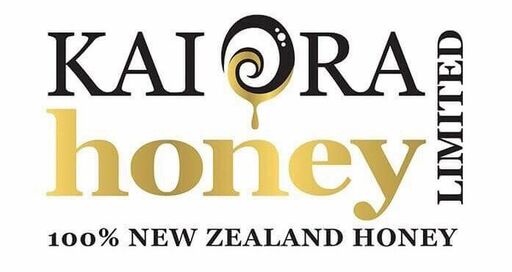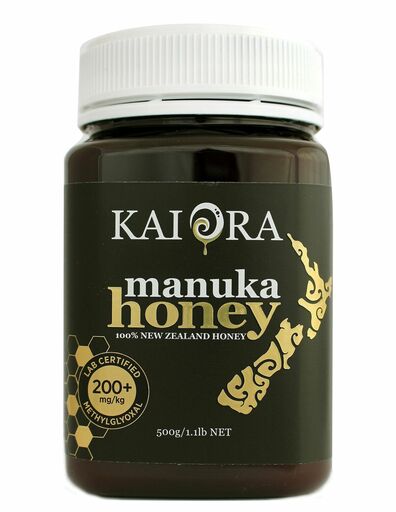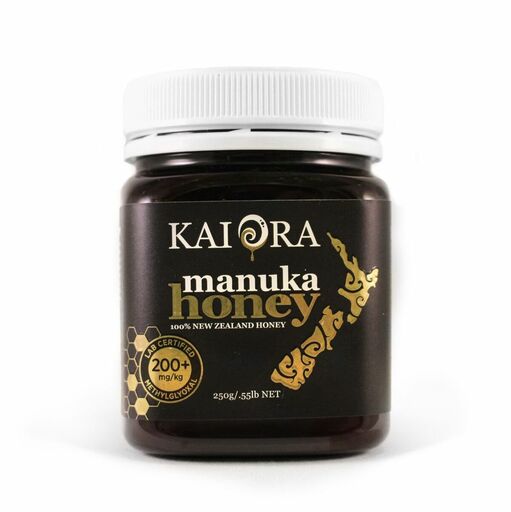
AQ Assured by AsureQuality, New Zealand's Government-owned food assurance company.
Kai Ora Mānuka Honey MGO200+
250g/500g
PRODUCT ATTRIBUTES VERIFIED BY AQ ASSURED
- NZ FernMark
- New Zealand made
 Origin
Origin
Kai Ora Honey is 100% Maori owned and operated by descendants of the Ngati Kuri and Te Rarawa iwi of New Zealand’s far North. New Zealand Mānuka honey is produced by bees collecting nectar from the Mānuka plant (Leptospermum scoparium). Mānuka plants can be found growing throughout New Zealand.
Kai Ora Honey is produced by bees from some of their 2000 hives located in Kaitaia, in the North Island of New Zealand and uniquely harvested from native bush in the New Zealand’s far North.
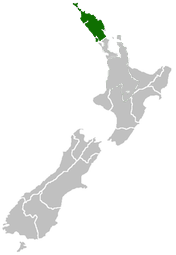
New Zealand Mānuka honey is produced by bees collecting nectar from the Mānuka plant (Leptospermum scoparium). Mānuka plants can be found growing throughout New Zealand.
Kai Ora Honey holds a NZ Fernmark License (License number: NZFM100160) which verifies New Zealand as its country of origin. The Fernmark license is a formal government recognition of Kai Ora Honey's connection to New Zealand.
Supply Chain
There are systems in place throughout Kai Ora’s supply chain to ensure that each jar of their honey meets high standards of safety and quality.
The Apiary
 Apiary Assurances
Apiary Assurances
- The apiaries where the hives are located are registered with New Zealand’s Ministry for Primary Industries, and comply with their annual hive inspection and reporting requirements.
- The beehives meet New Zealand requirements to construct beehives with materials that are not a source of hazard to the honey.
The Factory
The honey hive boxes are transported from the apiaries to the extraction factory in Kaitaia, accompanied by signed Harvest Declarations that detail the location the boxes have come from.
 Factory Assurances - Extraction
Factory Assurances - Extraction
- Honey supers are visually inspected for any contamination upon arrival at the extraction facility.
- The honey is extracted from the hive frames and stored in drums.
- Samples of honey are taken during the extraction process and tested by an accredited laboratory.
- The extraction factory is audited biannually by NZ Government-owned AsureQuality to ensure Risk Management Plan (RMP) requirements are met.
 Factory Assurances - Bottling
Factory Assurances - Bottling
- The honey drums are transported to the bottling factory.
- Kai Ora Honey is packed into jars and labelled with a batch number for traceability purposes.
- The final product is tested again at an independent accredited laboratory for authenticity, safety, quality and MGO.
- The bottling factory is audited biannually by NZ Government-owned AsureQuality to ensure Risk Management Plan (RMP) requirements are met.
- The final product is stored in a facility that operates to an audited Risk Management Plan to ensure quality is maintained.
Transport
This product is delivered from the storage facility to NZ Post, a New Zealand Government owned postal service.
 Transport Assurances
Transport Assurances
- The transport company that delivers Kai Ora Honey is required to have a current New Zealand Ministry for Primary Industries Risk Management Programme before it can carry any honey products, as per New Zealand’s Animal Products Act, 1999.
- This transport company is audited regularly by accredited personnel to ensure that the required standards are being met and maintained.
Shipping
Kai Ora Honey is packed to order, then transported via New Zealand Post, a New Zealand Government owned postal service, where it will be processed and tracked via barcoding and traceability systems until final delivery to the consumer via China Post.
Consumer
The package this honey is delivered in carries the AQ Assured brand and QR code on label for consumers to scan for more information on the safety and quality measures undertaken throughout the product supply chain.
 Environmental
Environmental
Kai Ora Honey have a goal of ecological restoration in Northland, New Zealand and have recently worked with local Iwi Ngati Kuru in a project to document the biodiversity in the region to support this.
Bees play a crucial role in the environment and Kai Ora Honey supports the Save Our Bees Charitable Trust, which was founded to conserve and protect New Zealand Honey Bees. Its aims are to educate people about the importance of bees in New Zealand horticultural and agricultural industries and in the home garden.
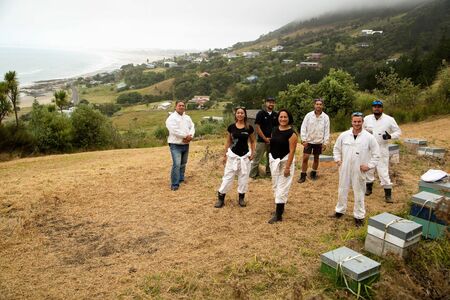
 Social & Ethical
Social & Ethical
Kai Ora Honey are working to deliver positive economic outcomes for the Te Tai Tokerau region and support local businesses through their production process, using local extraction and bottling facilities.
They support local schools, community events and sports clubs through sponsorship, and are actively engaged with their whanau, and Iwi via meetings, reporting and visits.
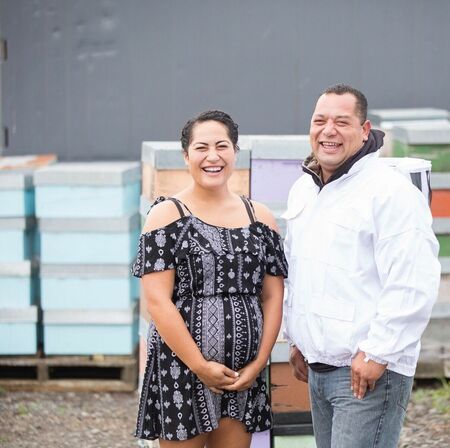
 Safety & Quality
Safety & Quality
Safety and quality are important to Kai Ora Honey and they take precautions to ensure their honey meets high safety and quality standards.
Laboratory Testing
During the extraction process, samples of honey are sent to an accredited laboratory to be tested, then the final product is tested again for authenticity, safety, quality and MGO levels.
MGO is methylglyoxal, a naturally occurring compound within Mānuka honey. Sometimes referred to as MG, this is one of the compounds tested to determine the quality and purity of Mānuka honey. The higher the MGO rating the more methyglyoxal present in the honey.
Kai Ora Honey meets the Ministry for Primary Industry’s requirements for all honey labelled as Mānuka for export be testing by a recognised laboratory ensuring that it meets the scientific definition of Mānuka honey. The Mānuka honey definition is made up of a combination of 5 attributes (4 chemicals from nectar and 1 DNA marker from Mānuka pollen).
Auditing
All Kai Ora Honey’s extraction, bottling, transport and storage facilities are audited to verify the requirements of the Risk Management Programme (RMP).
 Nutrition
Nutrition
This product is 100% NZ honey.
This batch of honey has been independently tested to contain at least 200+ MGO per kg.
